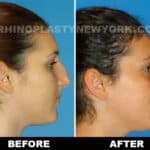Considering Rhinoplasty? What to Know Before Summer
As summer approaches, many patients begin contemplating rhinoplasty to enhance their appearance before the season of outdoor activities, vacations, and social gatherings. While the warmer months might seem like the perfect time for a nose enhancement, there are several important factors to consider regarding timing, recovery, and protection that can significantly impact your rhinoplasty experience and results.
Understanding Your Rhinoplasty Options for Summer
At our Manhattan, New York, and New Orleans, Louisiana practices, we offer several approaches to rhinoplasty that can accommodate different summer timelines and aesthetic goals:
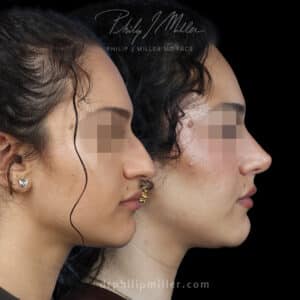
Traditional Rhinoplasty
Our comprehensive surgical rhinoplasty provides the most dramatic and permanent results for reshaping your nose. This option requires the most recovery time but delivers transformative results for those with significant aesthetic or functional concerns.
MicroRhinoplasty™
For patients seeking subtle refinement of their nasal bridge contour, our innovative MicroRhinoplasty™ offers a less invasive alternative with significantly shorter recovery time. Unlike traditional rhinoplasty that may require bone fracturing (osteotomy), MicroRhinoplasty™ uses an air-powered microrasp to precisely refine the nasal profile layer by layer, creating smoother, more harmonious facial proportions.
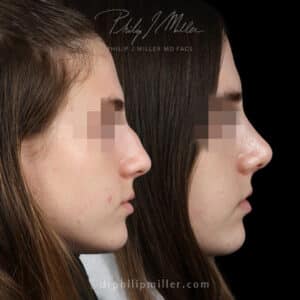
The benefits of MicroRhinoplasty™ for summer planning include:
- Procedure completed in as little as 5 minutes under local anesthesia
- Minimal pain, swelling, and bruising
- Return to normal activities within 1-2 days
- Precision results for specific nasal bridge concerns
Non-Surgical Rhinoplasty
For patients who want enhancement with virtually no downtime, our non-surgical rhinoplasty (or “liquid rhinoplasty”) offers immediate results using injectable fillers to reshape and refine the nose without surgery. This quick procedure can:
- Correct nasal irregularities
- Refine the nasal tip
- Enhance symmetry
- Camouflage mild humps
- Provide immediate results with minimal downtime
Results typically last between 8 and 24 months, making this an excellent option for those who want a summer-ready nose with no surgical recovery.
Timing Your Rhinoplasty for Optimal Summer Results
If you’re dreaming of showing off your new profile at summer events, planning ahead is essential. Each rhinoplasty approach requires different timing considerations:
Traditional Rhinoplasty Timeline
Most patients experience visible bruising and swelling for 1-2 weeks following traditional rhinoplasty surgery. While you’ll be presentable after your splint is removed (typically after one week), residual swelling can persist for several months. The most noticeable improvements occur within the first month, but your nose continues to refine and settle into its final shape over the course of a year.
For summer planning purposes, I recommend scheduling your traditional rhinoplasty at least 4-6 weeks before any major events or vacations. This timeline allows for:
- Initial healing of visible bruising and swelling
- Removal of all external dressings and splints
- Return to most normal activities
- Sufficient healing before exposure to summer elements
MicroRhinoplasty™ Timeline
With significantly less downtime than traditional rhinoplasty, MicroRhinoplasty™ can be scheduled much closer to summer events. Most patients can return to normal activities within 1-2 days, though strenuous activity should be avoided for 4-6 weeks. For optimal results, schedule your MicroRhinoplasty™ at least 2-3 weeks before major summer events.
Non-Surgical Rhinoplasty Timeline
The ultimate option for last-minute summer enhancement, non-surgical rhinoplasty delivers immediate results with virtually no downtime. Most patients can schedule this procedure just days before an important event, as any minor swelling typically resolves within 24-48 hours.
Recovery From Rhinoplasty: What to Expect
Understanding the recovery process is crucial for planning your summer rhinoplasty. Here’s what to expect during the weeks following your procedure:
First Week After Surgery
- You’ll wear a splint for protection and support
- Expect bruising and swelling around the nose and eyes
- Sleep with your head elevated to minimize swelling
- Avoid strenuous activities and keep the nose protected
- Have someone with you for the first 24-48 hours after surgery
2-3 Weeks After Surgery
- Most visible bruising and swelling will subside
- You’ll feel comfortable going out in public
- Makeup can be used to cover any residual discoloration
- Nasal congestion should begin to improve
- You can resume light activities like walking
3-6 Weeks After Surgery
- Resume cardiovascular activities like jogging and swimming
- Visible swelling and bruising should be virtually gone
- Breathing should continue to improve as internal swelling decreases
- You can typically resume wearing glasses around 6 weeks post-surgery
Full Recovery Timeline
While you’ll look presentable within a few weeks, complete healing takes time. Most patients see their final results develop over 6-12 months as subtle swelling continues to resolve and the nasal structures fully settle.
Summer-Specific Rhinoplasty Considerations
Sun Exposure Precautions
One of the most critical factors to consider for summer rhinoplasty is sun protection. The skin on your nose will be particularly sensitive following surgery, and excessive sun exposure can lead to:
- Increased or prolonged swelling
- Hyperpigmentation of surgical scars
- Delayed healing
- Compromised aesthetic results
For at least three months following rhinoplasty, it’s imperative to:
- Apply broad-spectrum SPF 30+ sunscreen to your nose daily
- Wear a wide-brimmed hat when outdoors
- Limit direct sun exposure, especially during peak hours
- Consider seeking shade whenever possible
Water Activities and Swimming
Many patients wonder when they can resume swimming and water activities after rhinoplasty. While each patient’s recovery varies, general guidelines include:
- Wait at least 3-4 weeks before swimming in pools
- Postpone ocean swimming for 4-6 weeks due to salt water and potential contaminants
- Avoid diving and underwater swimming for at least 6 weeks
- Use extra caution with water sports to prevent accidental trauma to the nose
For non-surgical rhinoplasty patients, swimming can typically be resumed within 24-48 hours, while MicroRhinoplasty™ patients should wait at least 1-2 weeks.
Heat and Humidity Considerations
Summer heat and humidity can sometimes exacerbate swelling after rhinoplasty. To manage this effectively:
- Stay in climate-controlled environments when possible during peak healing
- Use cold compresses as directed to reduce swelling
- Stay well-hydrated
- Consider scheduling indoor activities during the hottest parts of the day
The NatraLook® Approach to Summer Rhinoplasty
At our practice, we utilize the exclusive NatraLook® process to ensure your rhinoplasty results align perfectly with your aesthetic goals. This approach is particularly valuable when planning a summer rhinoplasty, as it helps create a unified vision for your outcome that complements your overall summer confidence.
The NatraLook® consultation process involves:
- Comprehensive evaluation of your nasal structure and facial features
- Detailed discussion of your aesthetic goals and summer timeline
- Collaborative planning for natural-looking results that enhance your confidence
- Creation of a personalized treatment approach that considers your summer activities and events
Is Spring the Ideal Time for Rhinoplasty?
For many patients, spring represents the optimal time to undergo rhinoplasty with summer in mind. Scheduling your procedure in spring allows:
- Sufficient recovery time before summer vacations and events
- Cooler weather during the initial healing phase
- Less sun exposure during critical healing weeks
- Time to adapt to your new appearance before summer social gatherings
Most patients find that having their traditional rhinoplasty in April or May provides ample time to be fully “summer-ready” by late June or July. For MicroRhinoplasty™ or non-surgical options, procedures can be scheduled much closer to summer events.
Choosing the Right Rhinoplasty Approach for Your Summer Timeline
When considering rhinoplasty before summer, it’s important to align your aesthetic goals with your timeline:
- 6+ weeks before summer events: Ideal for traditional rhinoplasty with comprehensive reshaping
- 2-3 weeks before summer events: Perfect timing for MicroRhinoplasty™ for dorsal hump reduction
- Days before summer events: Non-surgical rhinoplasty for immediate enhancement with no downtime
During your consultation, we’ll discuss which approach is best suited to your specific needs, goals, and summer timeline.
The Benefits of a Pre-Summer Rhinoplasty
Beyond practical recovery considerations, there are several advantages to completing your rhinoplasty before summer:
- Enjoying your summer with enhanced confidence in your appearance
- Having your new profile featured in summer photos and memories
- Addressing both aesthetic concerns and functional issues (like breathing difficulties) before outdoor activity season
- Completing the most significant portion of your healing during a less socially demanding time
Rhinoplasty Near Me: Expert Care in Manhattan and New Orleans
Whether you’re in Manhattan, New York, or New Orleans, Louisiana, our specialized rhinoplasty expertise is accessible to you. As a double board-certified facial plastic surgeon with over two decades of experience, I provide patients with exceptional care and natural-looking rhinoplasty results that enhance summer confidence.
Schedule Your Consultation Today
If you’re considering rhinoplasty before summer, now is the ideal time to schedule a consultation. Together, we’ll create a personalized plan that aligns with your aesthetic goals and summer timeline.
Contact our Manhattan, New York or New Orleans, Louisiana, office today to begin your rhinoplasty journey and ensure you’re ready to put your best face forward this summer.
Your Most Beautiful Nose: Understanding Your Nose Type
Manhattan, New York, is a diverse city representing many ethnicities. While everyone has a unique nose shape, common ethnic features impact rhinoplasty concerns and ideal outcomes. Rhinoplasty, better known as a nose job, is a surgical procedure that improves the appearance of the nose by:
- Reshaping
- Reducing
- Straightening
- Removing a hump
- Refining the tip
Customizable rhinoplasty solutions are essential to achieve the most natural results, especially for ethnic rhinoplasty patients. Ethnic rhinoplasty is a procedure performed on patients of different ethnicities and can improve the nose while preserving ethnic identity.
Philip J. Miller, MD, FACS, is a double board-certified facial plastic surgeon surgeon with skill, expertise, and an artistic eye. He achieves impeccable and life-changing results for his patients and is highly qualified to perform even the most complex rhinoplasty procedures. He uses a unique approach with ethnic patients as their goals and concerns typically vary from Caucasian patients.
Dr. Miller’s Manhattan office works with many different nose types, including:
African American Noses
African American rhinoplasty is an ethnic reshaping procedure designed with specific and unique characteristics and concerns of African American patients. African Americans tend to have:
- Wide, low bridge
- Bulbous, under-projected tip
- Wide alar base
- The goal for many African American rhinoplasty procedures is to:
- Low bridge
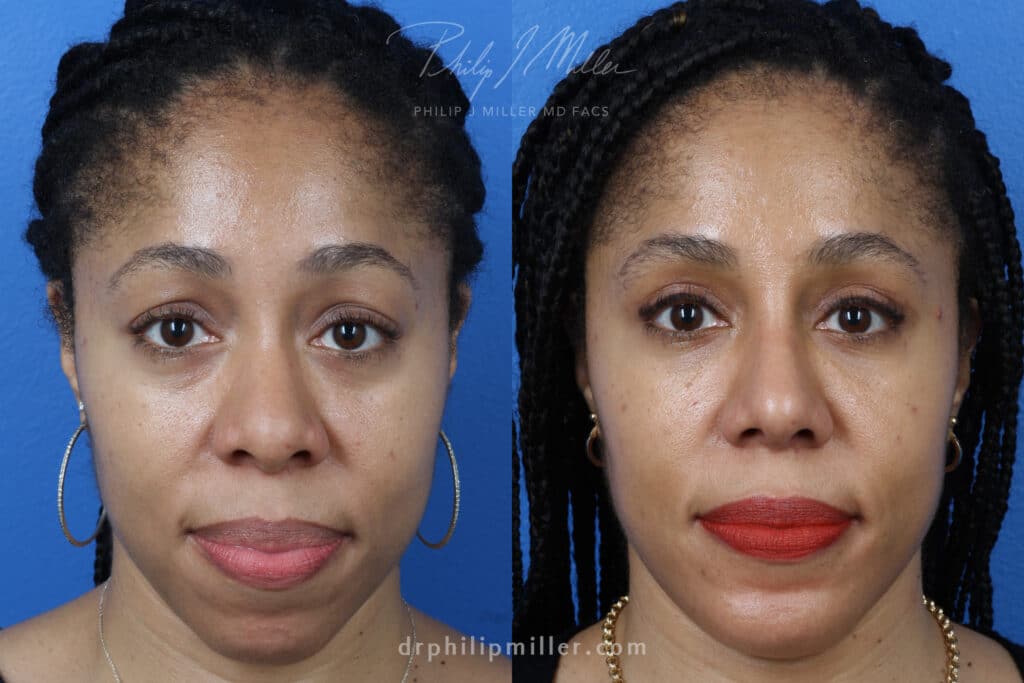
Dr. Miller recognizes the differences in nasal anatomy and can improve the nose while maintaining harmony with other facial features and ethnic heritage. As a skilled and experienced surgeon, Dr. Miller creates natural outcomes and avoids complications common in African American patients, such as keloid scar formation.
Asian Noses
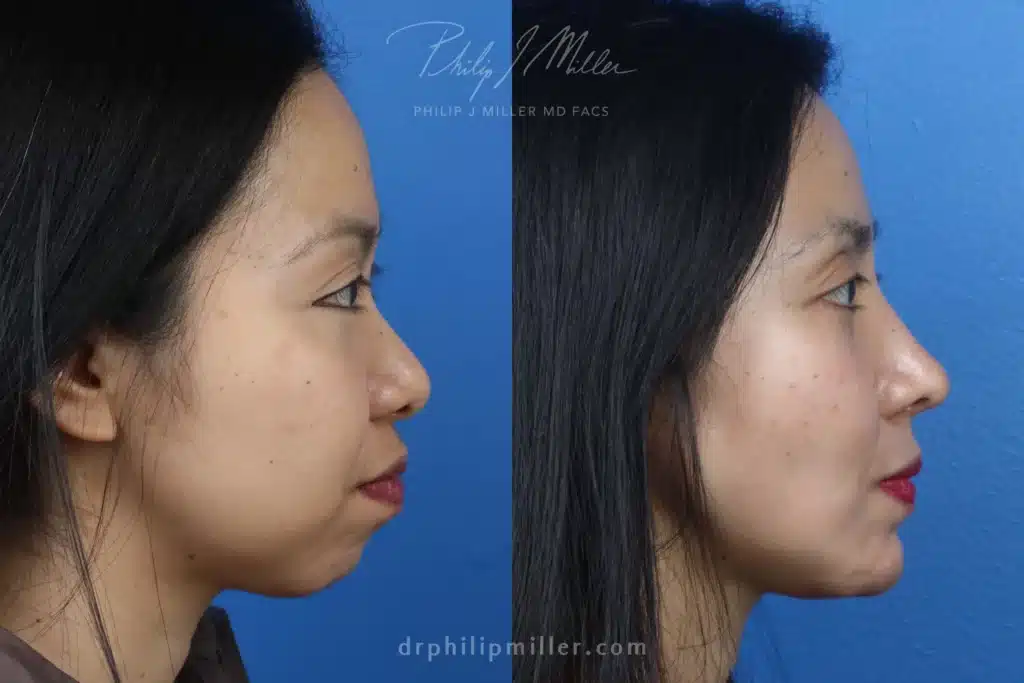
Each ethnicity has a different look and requires a specialized approach to rhinoplasty, including Asian patients. Many Asian patients experience common nose characteristics, including:
- A flat nasal profile
- A slight nasal bridge
- Flared nostrils
- A wide nasal tip
- Poor nasal tip strength
Asian patients often want to:
- Reduce flaring
- Have tip or bridge implants for a more prominent profile
While Korea is an Asian country, Korean rhinoplasty varies from the approach to Asian rhinoplasty. Korean patients experience a flatter nasal profile, slight nasal bridge, broad nasal tip, and wide nostrils. Without overcorrecting, Dr. Miller can:
- Narrow nostrils
- Fix an overly punched tip
- Correct an over-augmented bridge
Dr. Miller is committed to creating a personalized treatment plan with an approach central to your ethnicity. With more than 20 years of experience, Dr. Miller can produce natural and beautiful results in his Manhattan, New York location.
Hispanic/Latino Noses
There are more than 52 million Hispanic and Latino individuals in the United States, making Hispanic rhinoplasty an increasingly popular procedure in Manhattan. There is so much diversity within the Hispanic and Latino communities, it requires special consideration for small ethnic groups regarding rhinoplasty procedures. Hispanic patients share common nasal features such as thick skin and a bulbous nasal tip that is difficult to refine with traditional methods. Other categories include:
- Spanish heritage: a large bridge
- Caribbean heritage: wide, flat nostrils
- Central and South American heritage: flatter nasal tips and bridges
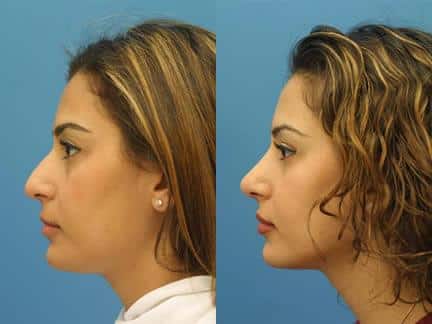
These differences call for three distinct rhinoplasty procedures:
- High bridge with a hump: The cartilage is shaved down, and the bone is rasped to remove the hump
- Under-projected, dependent tip: The tip of the nose is raised and projected with supplemental cartilage
- Shorter, flatter nose with a broad nasal base, thick skin, and a wide tip: The shape of the nose is refined by narrowing the base and raising the bridge
Dr. Miller works extensively with patients on how to approach the procedure and how to maintain a natural and ethnic-looking appearance.
Middle Eastern Noses
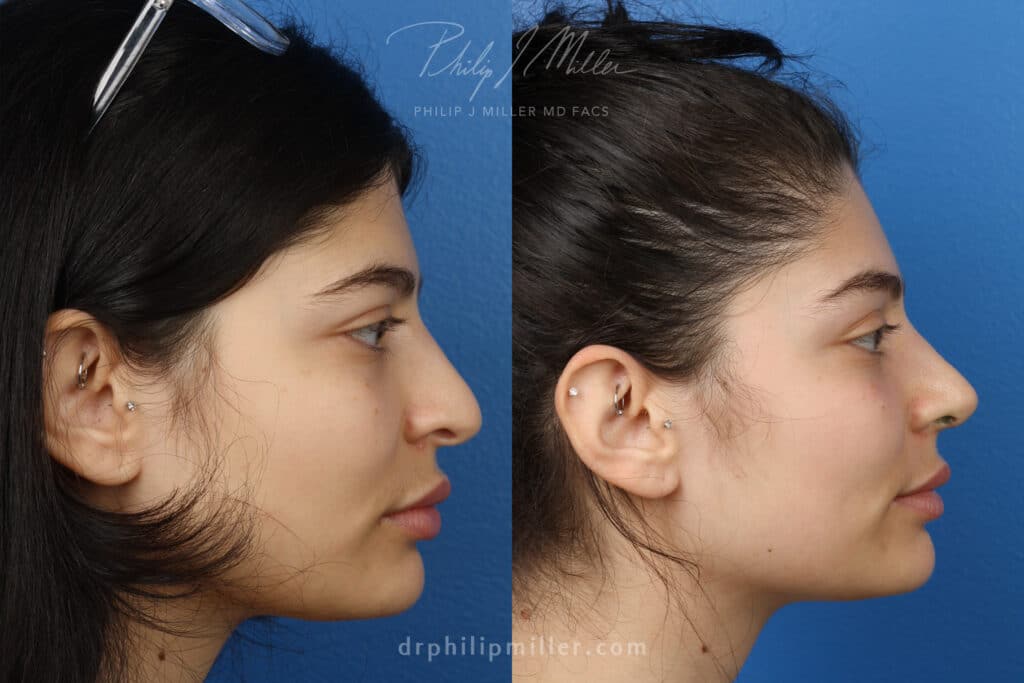
Mediterranean and middle eastern rhinoplasty patients experience common nasal characteristics such as:
- Thicker facial skin with fattier tissue
- Longer noses and a higher bridge
- Droopy tips
- Nasal humps
- Asymmetrical nostrils
- Wide bones
The goal of middle eastern rhinoplasty is to create:
- More symmetry
- Facial balance
Less experienced surgeons may create undesirable results, but Dr. Miller is a skilled surgeon that is knowledgeable about ethnic nose reshaping techniques. He can help create the best nose with ethnic rhinoplasty or revision rhinoplasty.
Indian Noses
With special techniques and years of experience, Dr. Miller can improve the shape of Indian noses without impacting ethnic identity with Indian rhinoplasty. Common nose characteristics for this ethnicity include:
- Rounder nasal tip
- Wider nasal structure
- Thicker skin on the nose
- A nasal shape that slopes downward
- Hump or bump on the nasal bridge
You can schedule a consultation in Dr. Miller’s Manhattan office to discuss all your concerns and identify if Indian rhinoplasty is right for you.
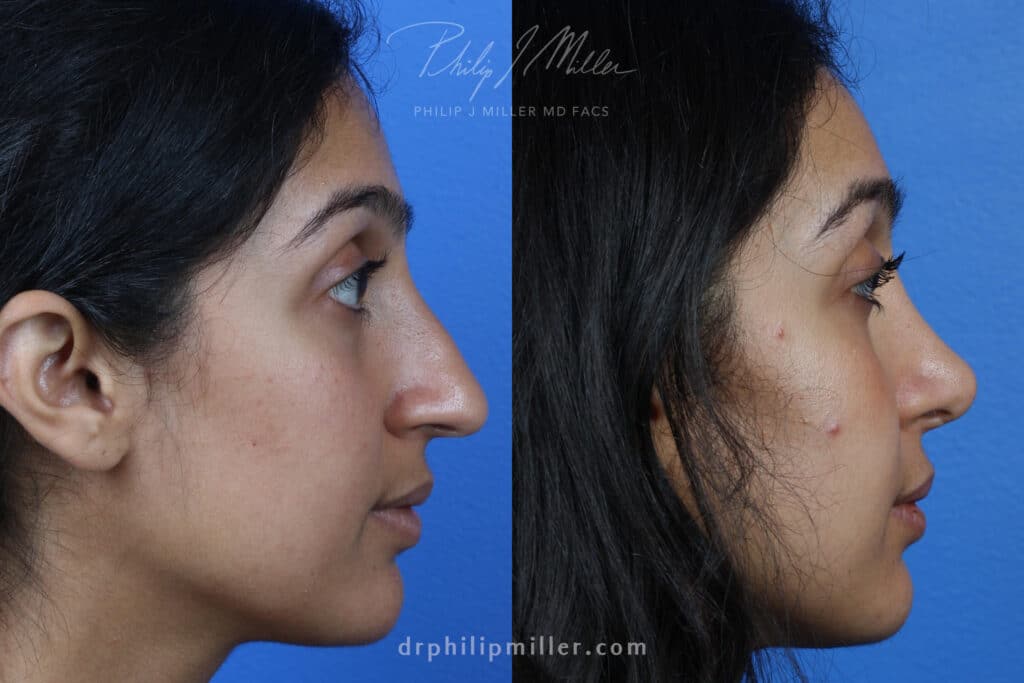
Other Types of Noses
There are many other ethnic nose shapes such as Greek, Persian and Jewish noses. Greek noses typically have a straight bridge without bumps or curves. It is a common reference as many rhinoplasty patients want a straight bridge for a sleek-looking profile.
A Persian nose has:
- Large nasal profile
- Downward sloping of the nasal bridge
- Bulbous nasal tip
A Jewish nose has:
- Amorphous nasal tip
- Over projected nasal tip
- Large dorsal hump
Getting Positive Results with Ethnic Rhinoplasty
Dr. Miller utilizes the NatraLook® Process to ensure the most natural and pleasing results for any procedure, especially complex treatments like rhinoplasty. The NatraLook Process is critical to achieving a unified vision and executing intended results specific to ethnicity. Evaluating the entire face is vital to achieving balance, beauty, and natural-looking features.
#1 NYC facial plastic surgeon, Dr. Miller, has years of experience with ethnic patients and has the skills to create natural and ethnically centered rhinoplasty procedures. Contact Dr. Miller’s Manhattan, New York, office to schedule a consultation and learn more about ethnic rhinoplasty.
What is Dorsal Reduction?
Dorsal reduction rhinoplasty surgery is a procedure that removes excess cartilage and bone from the nose, refining its appearance and improving its proportion to the rest of the face.
Philip J. Miller, MD, FACS, a double board-certified facial plastic surgeon in Manhattan, New York, and one of the country’s foremost experts in rhinoplasty, can assist female and male patients alike in achieving a nose they’ll love. You may elect traditional dorsal reduction rhinoplasty to reshape or reduce the nose. Other patients may benefit from non-surgical rhinoplasty for subtle corrections that achieve their desired aesthetic goals.
What is dorsal reduction?
Dorsal reduction rhinoplasty is a surgery that removes excess cartilage, bone, and skin from the nose, giving it a straighter, more streamlined look. This can help enhance the appearance, create facial symmetry, and improve breathing through the nose by reducing nasal obstruction or deviation.
The procedure can make the bridge of the nose narrower and straighter, and is often performed on patients whose noses are too large for their facial features or who have noses with an unusual shape. Dorsal reduction is often performed on people with prominent noses, such as those of Italian or Greek heritage.
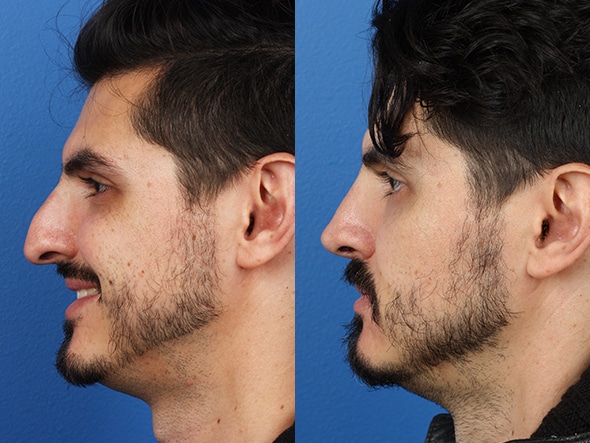
What causes a dorsal hump?
A dorsal hump appears on the slope of the nose from the bridge to the tip and can affect your facial profile. A dorsal hump is most noticeable when viewed from the side of the face.
The majority of dorsal humps are inherited genetically. As a result, if your parents or siblings have a prominent dorsal hump, you may as well. Dorsal humps may occur due to a traumatic physical injury—such as a sports injury or car accident—if the bone or cartilage heals unevenly. Whatever the cause of a dorsal hump, Philip Miller, MD, FACS in Manhattan can correct it and give you an aesthetically pleasing, balanced profile.
Benefits of Dorsal Reduction
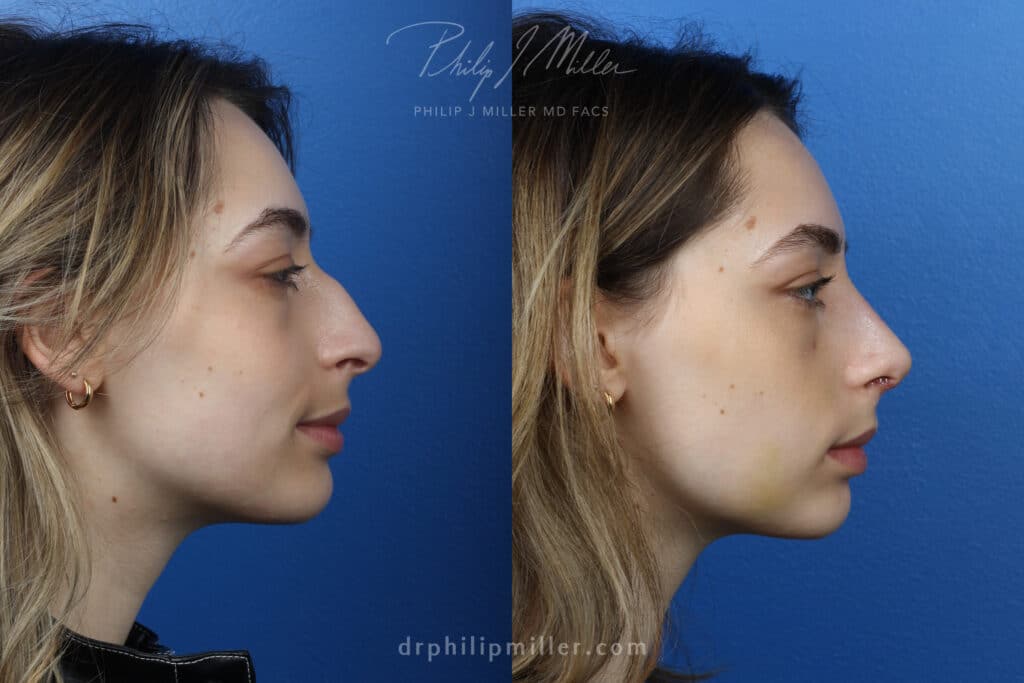
The benefits of dorsal reduction rhinoplasty include improved self-confidence and a positive self-image. However, since dorsal humps are often the result of genetic heritage, the procedure may cause identity issues for some ethnic patients. This is why it is so important to rely on an expert surgeon’s skills to achieve the goals of an ethnic nose job without affecting other ethnicity-related facial features.
How is dorsal reduction performed?
Open Rhinoplasty. During an open rhinoplasty, the surgeon makes a small Z-shaped incision between the nostrils on the underside of the nose. The open approach enables the surgeon to make more precise and accurate adjustments to your nose’s shape. Although open rhinoplasty leaves a small scar, it fades quickly with proper care.
Closed Rhinoplasty. Closed rhinoplasty is a procedure in which the surgeon makes incisions inside the nose without affecting the skin. The primary disadvantage of this approach is that the bone, cartilage, and tissue are not visible to the surgeon. However, this procedure results in less swelling than open rhinoplasty and can correct minor flaws.
MicroRhinoplasty. During a MicroRhinoplasty procedure, Dr.Miller accesses the treatment area via a small incision in the nostril. Then, using a specialized microrasp, he meticulously removes the protruding bony layers until the desired contour is achieved. Patients experience minimal discomfort, swelling, and bruising and typically resume normal activities within a few days.
Liquid Rhinoplasty. A liquid—or nonsurgical—rhinoplasty uses dermal fillers to reshape the nose without stitches or incisions. While liquid filler can’t make a nose appear smaller, it can correct minor indentations or asymmetries without requiring surgical intervention.
Recovery After Dorsal Reduction
Most patients are pleasantly surprised by how little pain they experience following dorsal reduction rhinoplasty surgery. The most unpleasant aspect of postoperative recovery is difficulty breathing through the nose for several days because of swelling. This difficulty usually resolves within a week or two. Expect some swelling around your eyes for several weeks. Once the swelling diminishes, you’ll start to see improvement.
You’ll need to follow certain precautions during your recovery period. Because bending or lifting can exacerbate swelling, it’s not recommended for the first three weeks following surgery. No strenuous activity such as running, weight lifting, cycling, or cardio training should be resumed for three weeks. Contact sports should be avoided for six weeks to allow the bones to heal completely. You may drive once the swelling has subsided sufficiently to allow for clear vision. Air travel is permitted 2-3 weeks after your surgery.
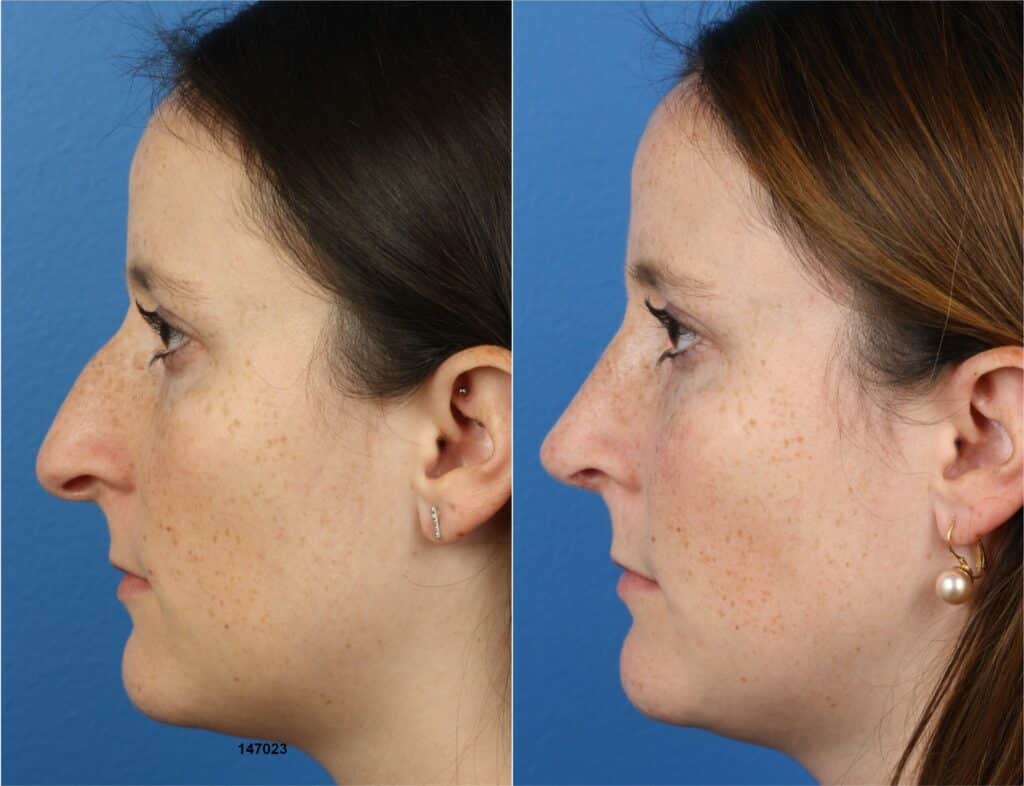
Scarring After Dorsal Reduction
The size and location of scars will depend on how extensive your treatment is because dorsal reduction involves removing sections of bone, cartilage, and skin tissue.
Scars from this procedure are typically hidden within the nasal skin creases and won’t be visible when you look straight ahead. Many patients choose topical treatments to minimize scarring.
Is Dorsal Reduction Right for You? Ask the Expert
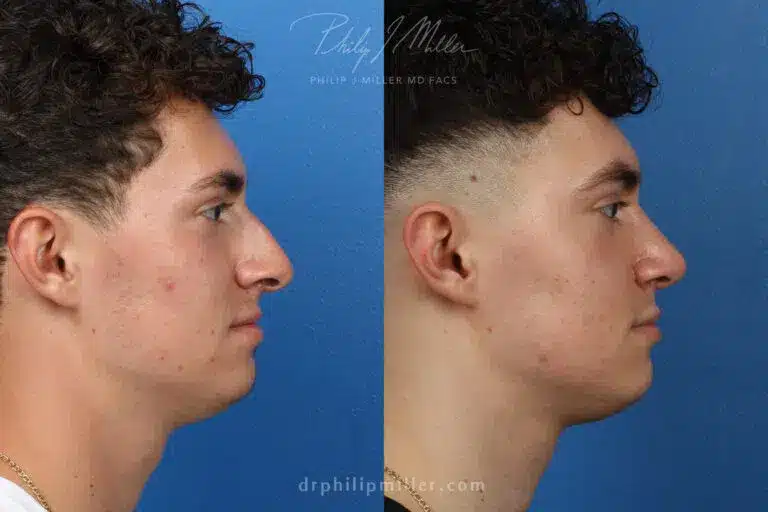
Why should you consult with Dr. Miller about your dorsal reduction procedure?
- Dr. Miller has over two decades of experience in facial plastic surgery.
- He has performed over 5,000 successful procedures.
- He is a facial plastic surgeon of international renown.
- He blends art and science to provide his patients with beautiful, natural-looking results.
In addition to these qualifications, Dr. Miller offers his patients the exclusive NatraLook process, which combines minimally invasive techniques and advanced procedures to help each patient achieve the Aesthetic Confidence® they desire.
Schedule a Dorsal Reduction Consultation in New York
To learn more about dorsal reduction rhinoplasty in Manhattan, contact our office to set up a consultation with Dr. Miller, #1 NYC facial plastic surgeon. You can fill out our convenient contact form or call us. One of our patient advisers will be happy to help you start the journey to a new, improved you.
5 Clues You Might Need Revision Rhinoplasty
Problems with your rhinoplasty procedure? Not happy with the results? Don’t lose hope—you can still achieve the look and functionality you want with revision rhinoplasty. Revision rhinoplasty is a surgical procedure to correct undesirable outcomes or treat persistent issues the original surgery did not address.
Philip Miller MD, FACS, a double board-certified facial plastic and reconstructive surgeon, can perform successful rhinoplasty and revision rhinoplasty procedures in Manhattan, New York. Dr. Miller has more than two decades of experience performing surgical and non-surgical procedures and can help you reach aesthetic confidence with revision rhinoplasty.
Why is revision rhinoplasty so common?
Revision procedures are common because the initial rhinoplasty is one of the most complex of all plastic surgery procedures. Some plastic surgeons do not have the skills, experience, and training to perform this procedure well, leading to botched surgeries and undesirable results.
The nose contains thin cartilage that requires expert handling to achieve successful cosmetic or functional outcomes. A study from the Aesthetic Surgery Journal found the average rate for revision rhinoplasty to be nearly 10%. Other factors that include increased revision rhinoplasty rates include:
- Outdated techniques or equipment
- Lack of doctor-patient communication
- Complications that impact the healing process and results
There are several common indicators that revision rhinoplasty may work for you. Take a look:
Clue #1: Your Nose is Not Symmetrical
Many patients feel their nose looks asymmetrical after rhinoplasty and that it was not adequately shaped. A poorly performed rhinoplasty procedure can result in a nose that appears uneven, disproportionate, or even off-center. Revision rhinoplasty can create a more natural, even look to compliment your entire facial structure.
After completely healing from rhinoplasty, you can assess the symmetry of your nose, and if you are unsatisfied, revision rhinoplasty may be right for you.
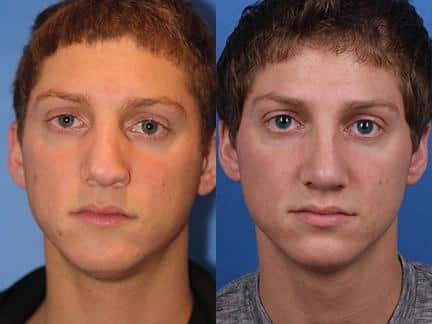
Clue #2: Your Results don’t Look Natural
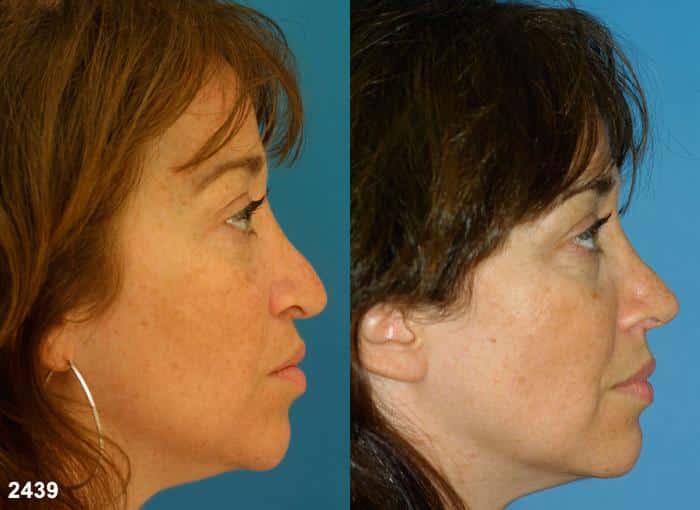
An initial rhinoplasty procedure may have removed too much or too little tissue and can lead to an unnatural nose shape. It can also cause a build-up of scar tissue that needs to be surgically removed. Unnatural-looking noses can be resolved with revision surgery. Potential unnatural-looking results include:
- Pinched Tip: A frequent complaint where the end of the nose appears compressed and leads to unwanted aesthetics and impaired breathing. This occurs when too much cartilage is removed from the tip of the nose, diminishing support over time.
- Short Nose: Just as it sounds, a nose can appear short and stubby due to the removal of too much cartilage. Specialized grafts act as support and restore a longer, more natural-looking shape.
- Crooked Nose: Typically derived from nasal trauma or a result of an initial rhinoplasty, a crooked or twisted nose is uneven and unnatural. Revision can rearrange the cartilage and bone to create a symmetrical, pleasing look.
Dr. Miller utilizes the NatraLook® Process to ensure the most natural and pleasing results. The NatraLook Process is critical to achieving a unified vision and executing intended results. Evaluating the entire face and how features relate to each other, as well as skin quality and thickness, all play a part in creating a beautiful, natural look.
While an unsatisfactory rhinoplasty can be very upsetting to a patient who has invested time and money into the process, many issues can be resolved with revision rhinoplasty. Dr. Miller performs revision procedures in his Manhattan, New York office to restore your confidence and achieve a natural look.
Clue #3: You are Disappointed in Your Results
If doctor-patient communication was lacking, or the procedure did not go as planned, many patients can feel disappointed in the results. Skill and experience are not the same. Surgeons may know how to do some nose shapes and resizing but may not have as much experience with a broader range of requests and or techniques. Your nose should be proportional and harmonious with other facial features, which means rhinoplasty is not a one-size-fits-all endeavor.
Even if the shape is ideal, patients may find other imperfections that cause dissatisfaction. Revision rhinoplasty can refine subtle areas such as:
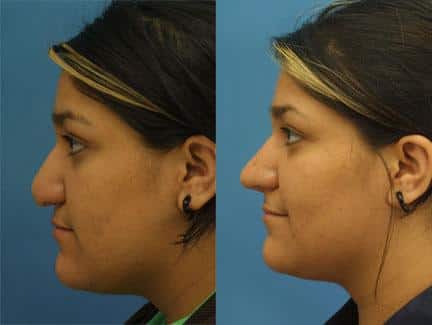
- Narrowing the nostrils
- Lifting the nasal tip
- Thinning or lifting the tissue that separates the nostrils
- Smoothing bumps on the surface of the nose
Revision rhinoplasty is a solution for major or minor alterations so that you feel good about your look. Dr. Miller uses his years of expertise to create patient-centric plans that result in stunning aesthetics to satisfy individual beauty goals.
Clue #4: Your Nose isn’t Working Properly
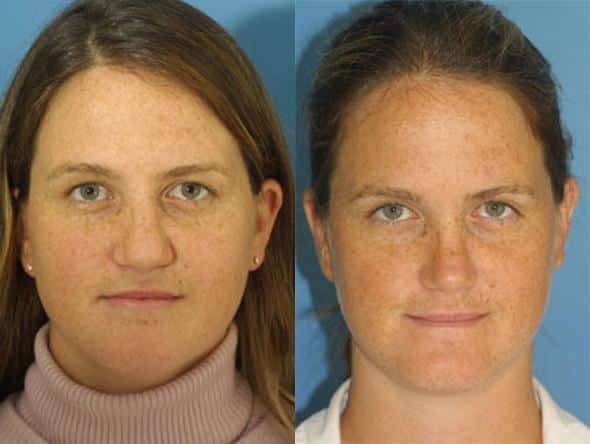
Not only should your nose look amazing, but it should also function properly. Improper nose function can be due to rhinoplasty surgery that does not heal properly or a functional issue that was not resolved or was created from a rhinoplasty procedure. The nose is a significant structure that impacts breathing and sinus issues. Revision rhinoplasty can help you get your dream nose and optimize function to reduce or eliminate problems that can interfere with breathing and sleep.
Clue #5: An Injury Occurred Since Your First Surgery
Rhinoplasty is a superior choice for nose shaping and sizing, but it does not make your nose invincible. The nose is still susceptible to injury and trauma, especially within a year or two after surgery. Due to the restructuring of cartilage and tissue, the nose can often be more fragile. If you endure an injury or trauma to the nose, it can be repaired through revision rhinoplasty. Dr. Miller works closely with Manhattan patients to ensure cosmetic and functional concerns are addressed when trauma or injury has occurred.
How Long Should You Wait for Revision Rhinoplasty?
Healing varies by individual, but most surgeons request patients wait 12-18 months before undergoing secondary rhinoplasty surgery. The healing process is long and crucial for the nose to take its final form or function. The duration of swelling varies by patient and can cause the nose to look different than it will when completely healed. Rushing into a revision surgery is dangerous and can cause unnatural and unsatisfactory results.
Choosing Your Revision Rhinoplasty Surgeon
Plastic surgery is not a guaranteed process, but choosing an expert surgeon with years of experience and developed skills can positively impact results. Do not assume all plastic surgeons are the same—research a surgeon and their practice before committing, and do not be afraid to ask hard questions. A consultation is a time to learn more about the procedure, a surgeon’s credentials, and experience.
Dr. Miller is a highly reputable, double board-certified plastic surgeon with more than two decades of experience in cosmetic medicine. With his expert team, Dr. Miller has a high success rate of facial surgery procedures and has been voted among the Best Doctors in America for the past 10 years and Top Doctor of New York City. He uses innovative techniques for rhinoplasty and revision rhinoplasty that helps patients achieve their desired look and function.
Contact us today online or by calling 646-791-3025 to see if revision rhinoplasty is right for you.
Three Facial Plastic Surgery Procedures You’ve Never Heard Of
You thought you knew everything about facial plastic surgery and cutting-edge aesthetic procedures. And maybe you do! But if you don’t, the following are a few of the lesser-known surgical aesthetic enhancements that I perform for women and men who want to boost their physical appearance as well as their self-confidence. As a double-board certified facial plastic surgeon in New York City who also trained as an artist, my goal is to make you look like the very best version of yourself and increase your Aesthetic Confidence®:
Buccal fat removal
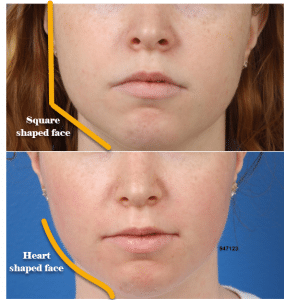 Your “chipmunk cheeks” were adorable when you were five, but now you want a sophisticated, sleek look that matches your personality and your level of achievement. By removing excess buccal (i.e. cheek) fat and tissue, I create a slender lower face that emphasizes and dramatizes your cheekbones.
Your “chipmunk cheeks” were adorable when you were five, but now you want a sophisticated, sleek look that matches your personality and your level of achievement. By removing excess buccal (i.e. cheek) fat and tissue, I create a slender lower face that emphasizes and dramatizes your cheekbones.
The entire outpatient buccal fat removal surgery only takes about an hour and can be done under general or local anesthesia. During this procedure, I make a small incision inside both cheeks, so you won’t have a visible scar. With care and precision, I sculpt away excess fat to create cheeks that are lean and beautifully contoured.
The incisions are then closed with dissolvable sutures. You can return to work or regular activities as soon as the next day. To learn more about buccal fat removal, visit ncbi.nlm.nih.gov
Learn more about getting the sculpted cheekbones you desire with our buccal fat guide.
G.I Jaw®
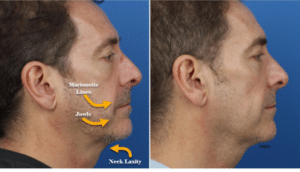
Looking to achieve a strong jawline through a cosmetic procedure has become so popular that according to the American Academy of Facial Plastic and Reconstructive Surgery, general plastic surgeries are on the rise. But my patented G.I. Jaw procedure is more than simply inserting a medical-grade jaw implant or building the jaw non-surgically with long-lasting dermal fillers. I may also recommend other changes to create a more masculine appearance, which keeps your new jawline in harmony with your other features. Recommendations may include:
- Submental liposuction
- Kybella® injectable fat removal
- Neck-Tite™ radiofrequency-based neck lift
- Surgical neck lift
- Chin or cheekbone implants
- Dermal fillers to build volume in cheekbones and mid-face
My aim is to create improvements that convey more strength and masculinity, while still looking natural and like yourself.
Inserting medical-grade implants is a minimally invasive procedure that can be done in the office under local anesthesia. You may experience some swelling or discomfort afterward. Generally, most men don’t have discomfort following a nonsurgical G.I. Jaw procedure performed with dermal fillers.
Learn more on how to transform and strengthen your face with our G.I. Jaw guide.
Micro-Rhinoplasty
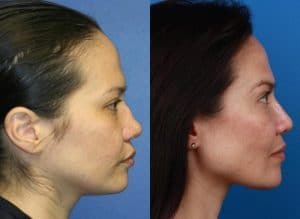
Do you want to improve the shape of your nose, but the idea of undergoing a full rhinoplasty — which requires breaking the nasal bone and cartilage and a healing period of up to one year — just doesn’t appeal to you? If you only want to remove bumps and lumps on your nose, I can perform a micro-rhinoplasty that requires just one tiny incision in your nostril, no bone breakage, and no significant downtime.
Using specialized tools, I insert a high-tech, air-powered micro-rasp into the incision and gently reshape your nasal bone and cartilage, sculpting away humps and bumps. The end result is a nose that’s straighter, more aesthetically pleasing, and in better harmony with the rest of your facial features.
Unlike traditional rhinoplasty, which is performed under general anesthesia and may take several hours, micro-rhinoplasty is done in my Manhattan office under local anesthesia. The entire procedure only takes about 5-15 minutes.
Your recovery time is also cut down. You’re swollen for a few days after your procedure but can return to most of your normal (non-strenuous) activities within 1-2 days.
Learn more about micro-rhinoplasty with our procedure guide.
Book a Facial Plastic Surgery Consultation in New York Today
When it comes to cosmetic surgery, your satisfaction with your results can have emotional and psychological benefits. It makes sense. When you look good, you feel good. If you’re ready to get your Aesthetic Confidence® back, contact Dr. Miller and his staff at his New York office today to schedule a plastic surgery consultation.
More like this,
